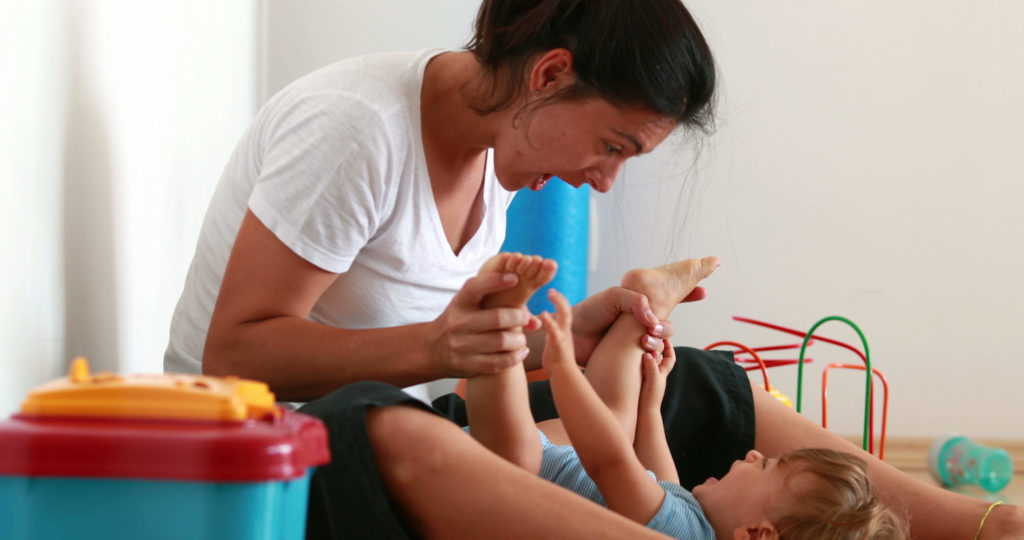Improving Childhood Development Through Play: It’s Not Just About the Brain

Remember the unencumbered bliss of playing as a child? Up in a tree, hushed under a fort, or giggling over a board game with friends, family, or maybe a special teacher by your side. Your body was relaxed and your mind was at ease. You had an amazing ability to focus your attention, with your playmates, on whatever fun task was at hand.
Playtime is a critical component of healthy development for kids. We hear a lot about why play is good for children’s brains, but something is going on inside children’s bodies when they’re in a playful state that has phenomenal impacts on their heart health, gut health, immune system, sleep quality, and stress resilience. Brain development is only one component of this amazing mechanism called autonomic co-regulation: the process of accessing our bodies’ most optimized state by connecting with each other.
Co-regulation is a cycle: we engage our five senses while connecting emotionally with someone we love, and our nervous systems calm each other down. That calm is the state in which our bodies can turn on all these productive and positive functions that support health and learning. It’s also great for building emotional literacy, empathy, and cooperation.
Because play is already so sensory, it’s a fantastic time to co-regulate! We may find ourselves alongside, but perhaps not engaged with, our children’s play. Sometimes, when our children ask to play, what they are really seeking is emotional connection with us—it is not just about play. And our participation makes all the difference in helping them get the benefits of a regulated nervous system. You might be surprised how much a play break restores your own sense of calm and wellbeing, and how clear-headed you feel in that state.
It’s really important for adults to co-regulate, but it’s absolutely vital for little bodies and brains. Co-regulation is a powerful way to nurture positive development, and you and your child can incorporate it (almost) whenever you want.
Here are some tips for making playtime and games opportunities to engage all five senses during play together:
- Sensory engagement is important. Here are some examples:
- Lots of games involve touch (like patty cake or tag)
- Peekaboo promotes eye contact and is a great way for young children to start developing that skill
- Children love to play games that involve songs or listening for commands (like red light/green light)
- Cooking can incorporate taste into play (even if the food is imaginary!)
- It is fun to play with smells. Have them close their eyes and guess the smell of grass, vanilla, tea, soap, etc. Smell is intricately linked to memory and emotion.
- Chase games are really important. You get to practice separation and joyous reunion with physical and emotional connection.
- Hide and seek is also a great reunion game for co-regulation, especially the “sardines” version, where you hide close together!
- While learning to understand and follow rules is an important benefit of playing games, the goal should be fun, not winning. If your child is too young to follow the rules and you make that the point of gameplay, it won’t be a joint activity for them because it won’t be fun. Co-regulation is all about coming together.
- Unstructured play, particularly when a child is allowed to lead it, is the best joint activity because you both learn how to collaborate with each other. Taking turns is important: learning to be cooperative and invested in others’ interests helps them integrate the vital “co-” part of co-regulation.
- When you say, “For the next 20 minutes, we’re going to play whatever you want to play,” you give a child a sense of confidence and excitement that you’re engaging with them. Witnessing their play is great, too. Sometimes they want to play alone. That’s okay—they probably still want you to watch! Adult-witnessed play fosters thinking and creativity.
- For very young children who play together, playing in the same space is often better than focusing on toys. If they’re fighting over toys, it’s dysregulating and they’ll get upset. Establishing play as a joint activity early on promotes better sharing skills down the road.
If you’re co-regulating, whatever activity you’re doing together is, by default, a joint activity. But simply doing an activity together doesn’t guarantee co-regulation; we have to be intentional about our connection. Playtime is sensory and fun, which makes it a gold mine of opportunity.
Our little ones are little now, but someday they’ll be grown-ups in the world. Co-regulatory play improves children’s motivation and learning capacity, and stimulates many of the biological and emotional functions they’ll need for future relating—in school, with coworkers, and even with their future children. When kids co-regulate, they condition their stress response to be flexible, resilient, and less reactive. And we adults can modulate our own stress responses better, sleep better, clear brain fog, boost our immunity, and live longer (yes, really).
Why do so many children grow up to go into fields their parents were in? Because they shared meaningful connection through joint activities. They learned to exchange interests. Some of my most cherished memories from childhood are playing with my parents. My dad was a research chemist, and my mom was an early childhood educator; I went into mother-child research as a physician; my parents continued to help me with my work until they died at 100. Relating through shared interest creates deep mutual enjoyment, and it’s never too late to start.
